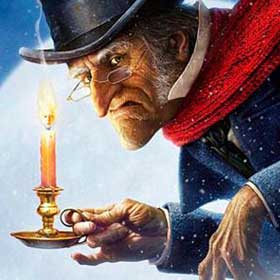A Christmas Carol

3/5
Robert Zemeckis, director and screenwriter of Disney’s A Christmas Carol, includes several action sequences in his film of the kind that high school students everywhere wish Charles Dickens had included in A Tale of Two Cities. Alas, Dickens did not have motion capture technology in Victorian England. The theatrical version was likely stunning, but the recent release of A Christmas Carol on DVD is disappointing, as will be the case with any film originally in theaters in 3-D. High-definition and Blu-ray technology can hardly compensate for the wonder of seeing characters dance around your living room.
Zemeckis, best known for his 1980s mega-franchise Back to the Future trilogy, shows a penchant for cutting-edge film technology by taking on his third consecutive motion capture movie. A Christmas Carol follows The Polar Express and Beowulf as animated features on which Zemeckis has used motion capture to push the animation genre to new levels of
expression. Motion capture also provides the raison d’etre for A Christmas Carol: a classic story offers fertile ground to play with new technology.
In fact, of the DVD's bonus features (most of which are marketing tie-ins unrelated to the movie) the behind the scenes look at how motion capture works might be more exciting than the film itself. As lead actor, Jim Carrey lends much more than his voice to the film. Decked out in a high-tech suit with sensors, helmet, and four hi-def cameras, Carrey acted out his roles on a giant soundstage. The motion was captured on computers and then "filmed" with a virtual camera. The
resulting scenes contain vivid imagery, and even without 3-D some of the shots are quite elegant.
A Christmas Carol is an enjoyable enough film, and kids who have never read nor seen a version of it will be delighted. However, one wishes the Zemeckis's raison d’etre extended beyond fancy equipment. The power of the story itself—the blackness of human desire twisted out of shape, the power of fear, the capacity of the human spirit for change—become afterthoughts in Zemeckis's techno-playground.
The problem is amplified on the DVD version: without 3-D effects the film loses its primary purpose. The ghosts (all played by Jim Carrey) may have leapt from the screen in theaters, but on a television they are unimaginative renderings. Can’t we do better than a semi-transparent Harry Truman and Lumiere from beauty and the beast? These ghosts lack the fantastical features needed to justify Scrooge's drastic character shift, and the dialogue follow suit.
The tracking shot in the opening credits likewise suffers from lack of impact. The camera carries viewers over rooftops and swoops down into the streets where vendors cry their wares. The shot includes beggars, fishmongers, and a lady selling a Christmas wreath through which the camera flies. The content of the shot is remarkable, but the effect loses its power without the various elements of Victorian London hovering off the screen.
One subtle element of the film that doesn't depend on 3-D for its power is the allusion to Greek myth Zemeckis added to the first scene. Scrooge stands over the coffin of his deceased partner Jacob Marley (the same man who will haunt him seven years hence as Harry Truman). In a bit of spoon-feeding, the camera zooms in on Scrooge's hand, shaking with reservation as it reluctantly releases the money needed to pay the undertaker. But then Scrooge glances at Marley's body in the open coffin and swiftly plucks two coins off his eyes. The shot is an allusion to ancient Greeks who placed coins on the eyes of the deceased to pay the boatman to ferry them into the underworld. This image in A Christmas Carol suggests in a way that even Dickens didn't just how depraved Scrooge is: he is willing to condemn a soul to eternal wandering and unrest for a few pence.
Disney's A Christmas Carol is lackluster relative to some of it's peers, but it is still an enjoyable film, because the cutting-edge technology adds a new layer to a timeless story, even if viewers of the DVD do not benefit from the full effect of motion capture. Dickens's story needed no help, so Zemeckis' adventures seem a bit whimsical, and while I would have preferred to see the film in theaters, the DVD is not a bad addition to one's Christmas library.
Starring: Jim Carrey, Gary Oldman, Cary Elwes
Director: Robert Zemeckis
Distributor: Disney
Runtime: 96 minutes
Rating: PG
RELATED ARTICLES
Get the most-revealing celebrity conversations with the uInterview podcast!





Leave a comment